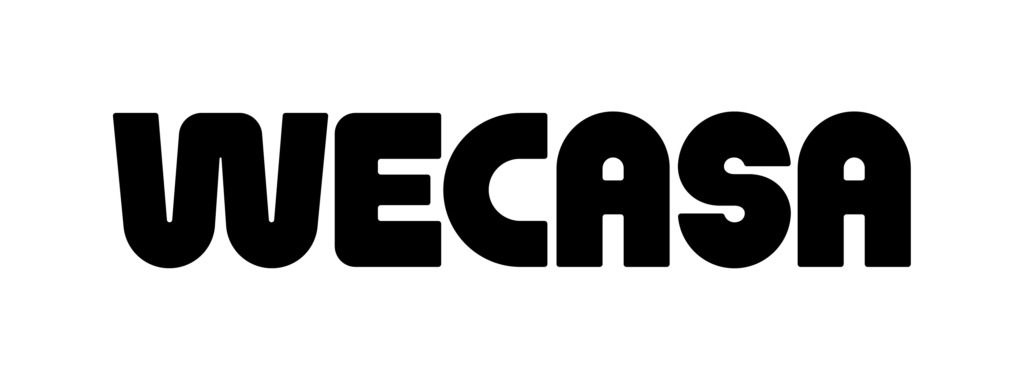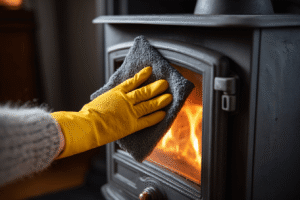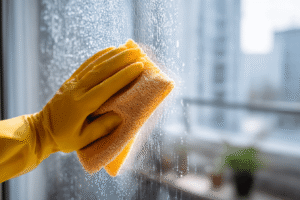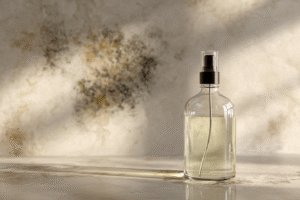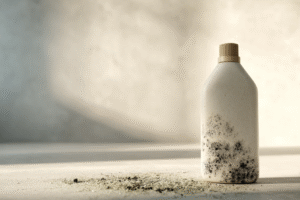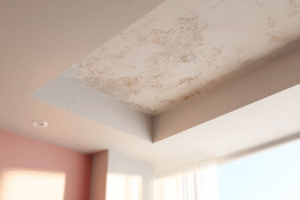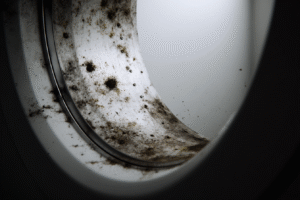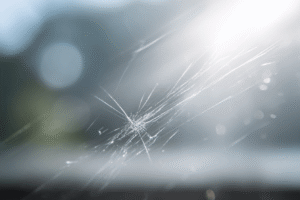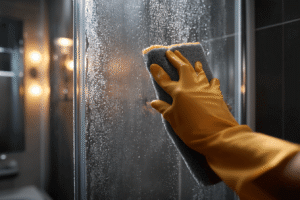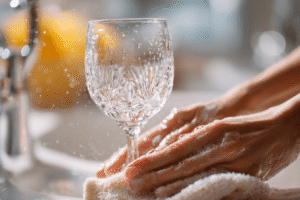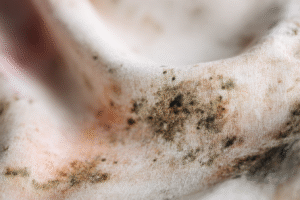At Wecasa, we understand that achieving streak-free, sparkling glass can feel like an impossible task. We connect you with professional cleaning expertise whilst sharing the techniques that transform your windows, mirrors, and glass surfaces from frustrating smudges into crystal-clear perfection.
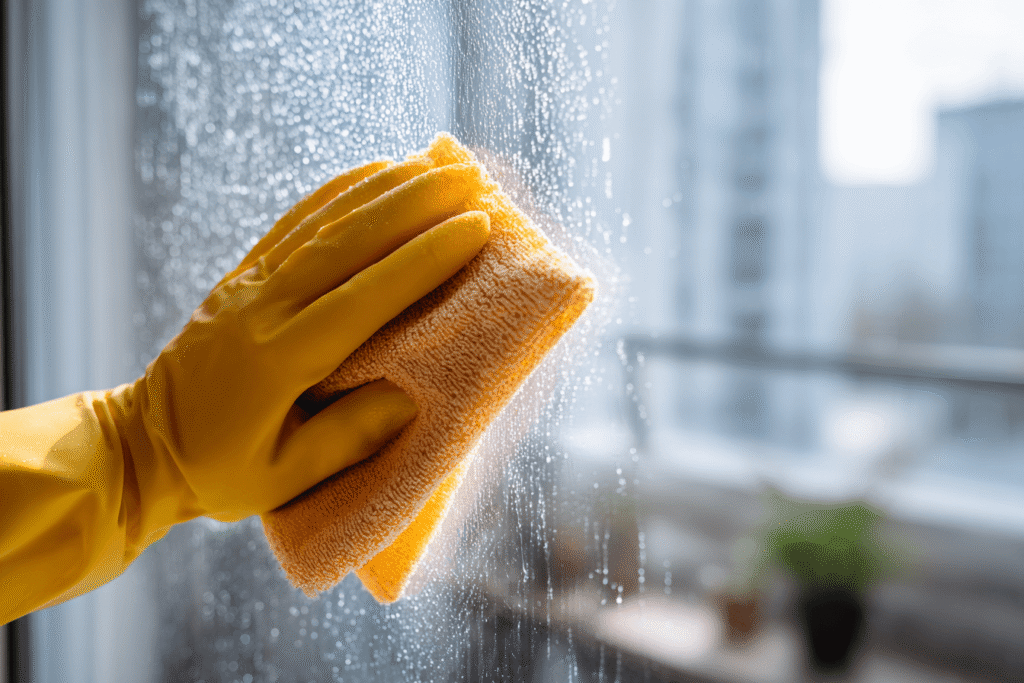
What you’ll need for streak-free glass cleaning
Essential tools and materials
Getting streak-free results starts with having the right kit in your cleaning arsenal…
- Microfiber cloth – the absolute champion…
- Spray bottles – for even distribution…
- Paper towels or lint-free cloths…
- Squeegee – brilliant for large windows…
The cleaning essentials:
- White vinegar – your best mate for cutting through grime
- Warm water (distilled is even better)
- Glass cleaner – choose ammonia-free versions
Remember: the right techniques matter more than expensive products…
Best cleaning cloths for different glass types
Choosing the right cloth transforms your cleaning game completely.
| Glass Type | Best Cloth | Why It Works |
|---|---|---|
| Windows & mirrors | Microfiber (waffle weave) | Traps dirt, dries streak-free |
| Eyeglasses & screens | Ultra-fine microfiber | Gentle, won’t scratch coatings |
| Shower glass | Terry cloth microfiber | Extra absorbent for soap scum |
| Glass tables | Lint-free microfiber | Smooth finish, no residue |
Pro tip: Use a side motion when buffing delicate surfaces…
What should you not clean glass with?
Steer clear of these common culprits that leave your glass looking worse than when you started. Paper towels are the biggest offenders – they leave behind lint and create those annoying streaks that drive you mad.
Avoid these glass-cleaning villains:
- Harsh chemicals containing bleach or ammonia – they damage seals and frames
- Abrasive materials like rough sponges or steel wool that scratch surfaces
- Dish soap in large quantities – creates thick residue that’s impossible to buff away
- Tap water in hard water areas – mineral deposits leave stubborn spots
Newspaper might sound old-school, but it’s actually brilliant for a final buff on windows. Just stick to black and white pages and wear gloves to avoid inky fingers!
Step-by-step glass cleaning techniques
What is the best way to clean glass?
The top-to-bottom cleaning method prevents drips from creating fresh streaks on areas you’ve already cleaned.
Follow this winning sequence:
- Spray your cleaning solution at the top of the glass surface first
- Wipe horizontally across the upper section using your microfiber cloth
- Move down in overlapping strips – each stroke should slightly overlap the previous one
- Finish with vertical passes to catch any remaining solution or streaks
| Surface Type | Starting Point | Direction |
|---|---|---|
| Windows | Top left corner | Left to right, then down |
| Mirrors | Upper edge | Side to side, working down |
| Glass doors | Top frame area | Horizontal strips downward |
The beauty of this method? Any cleaning solution that drips will land on sections you haven’t tackled yet, rather than ruining your hard work above.
Achieving streak-free windows and mirrors
Timing makes all the difference when you’re after that perfect, crystal-clear finish. Tackle your glass cleaning on overcast days – bright sunshine causes cleaning solutions to dry too quickly, leaving those annoying streaks behind.
Your winning approach:
- Spray cleaning solution onto your cloth rather than directly on the glass to prevent drips
- Work in small sections – about arm’s length at a time keeps you in control
- Use straight lines, not circles when wiping to avoid swirl marks and patches
The secret finishing touch? Once you’ve cleaned the surface, grab a completely dry microfiber cloth and buff in gentle, straight motions. This final step removes any remaining moisture or residue that could create streaks.
Remember: less is more with cleaning products. A light application does the job beautifully, whilst overdoing it just creates more work for you.
Professional squeegee technique for large surfaces
Large windows and glass doors need a proper squeegee – paper towels simply won’t cut it when you’re tackling expansive surfaces. Choose a 16-24 inch squeegee for picture windows and patio doors, whilst 10-12 inch models work brilliantly for standard windows.
Master the S-curve method that professionals swear by. Start at the top-left corner and move your squeegee in smooth S-shaped motions across the glass. Keep the leading edge angled slightly toward the dry surface – this prevents the blade from jumping or leaving moisture behind.
| Surface Size | Squeegee Width | Best Technique |
|---|---|---|
| Large windows (6 ft +) | 18–24 inches | S-curve method |
| Standard windows | 10–12 inches | Straight vertical pulls |
| Glass doors | 16–18 inches | Horizontal strips |
The secret? Light pressure and consistent contact. Press just enough to keep the rubber blade touching the glass – too much pressure actually works against you and creates streaks.
Cleaning different types of glass surfaces
Best way to clean eyeglasses and spectacles
Your specs deserve gentle treatment – harsh chemicals and rough materials can damage those specialist coatings that help you see clearly.
Start with clean hands to avoid transferring oils and dirt onto your lenses. Rinse your glasses under lukewarm water to remove dust particles that could scratch during cleaning.
| Lens Type | Best Cleaner | Avoid |
|---|---|---|
| Anti-reflective | Gentle dish soap | Alcohol-based sprays |
| Prescription | Lotion-free hand soap | Paper towels |
| Reading glasses | Microfiber cloth + water | Clothing fabric |
Apply one drop of lotion-free dish soap to each lens and gently rub with your fingertips. Rinse thoroughly and dry with a clean microfiber cloth using straight motions – never circular rubbing that creates swirl marks.
Quick daily maintenance? Keep pre-moistened lens wipes handy for on-the-go cleaning.
Glass shower doors and bathroom mirrors
Bathroom glass takes a proper beating from steam, soap scum, and those pesky hard-water spots that seem to appear overnight.
Your bathroom mirrors need different treatment than shower doors. Mirrors collect hairspray residue and toothpaste splatter, whilst shower glass battles soap scum and mineral deposits. Start with your mirror using a gentle vinegar solution – spray your cloth, not the surface, to prevent drips behind the glass.
For shower doors, tackle soap scum first with a paste of baking soda and water. Let it sit for five minutes, then wipe with circular motions before switching to your regular glass cleaner.
The game-changer? Keep a squeegee hanging in your shower. A quick swipe after each shower prevents 90 % of the buildup that makes deep cleaning such hard work later. You can see our step-by-step guide on how to clean your shower glass.
Best way to clean windows
Each of these surfaces has its own personality when it comes to cleaning challenges. Windows face weather and outdoor grime, glass tables collect fingerprints and food spills, whilst cooktops battle burnt-on splashes and heat damage.
Start with the gentlest approach for each surface. Windows need outdoor-strength cleaning – use your vinegar solution and work in sections to prevent streaking. Glass tables respond beautifully to simple dish soap and water, followed by a dry microfiber-cloth buff.
Cooktops require patience. Always ensure they’re completely cool before cleaning. For stubborn burnt-on spots, make a paste with baking soda and water, let it sit for 15 minutes, then gently scrape with a plastic scraper designed for glass surfaces.
Remember: what works brilliantly on your dining table might damage your cooktop. Match your method to your surface.
Best way to clean a mirror
Mirrors deserve special attention – they’re the first thing you see each morning and the last thing at night, so streaks and smudges are impossible to ignore.
Start with the right approach for your bathroom mirror or any mirror around your home. Mix equal parts white vinegar and warm water in a spray bottle for the most effective, streak-free solution.
- Spray your cleaning solution onto a microfiber cloth rather than directly onto the mirror – this prevents drips seeping behind the edges
- Work in an S-pattern starting from the top and moving systematically downward
- Use gentle, overlapping strokes to ensure complete coverage
- Finish with a dry microfiber cloth to buff away remaining moisture
The secret professional touch? Clean your mirrors when they’re cool and out of direct sunlight. Heat causes cleaning solutions to dry too quickly, leaving streaks that make you want to start all over again.
Remember: less cleaning solution works better than more. A light application with proper technique beats drowning your mirror in product every time.
Eco-friendly homemade glass cleaning solutions
Vinegar and water mixture for streak-free results
White vinegar cuts through grime like nothing else – its natural acidity dissolves mineral deposits and soap residue whilst leaving zero chemical trace.
The golden ratio? Mix 1 part white vinegar with 1 part distilled water in a spray bottle.
| Vinegar Type | Best For | Mixing Ratio |
|---|---|---|
| White vinegar | All glass surfaces | 1 : 1 with water |
| Cleaning vinegar (6 % acidity) | Stubborn stains | 1 : 2 with water |
Apply the solution sparingly – a light mist prevents oversaturation that causes streaking. Work in sections and wipe immediately with a microfiber cloth.
Natural alternatives to commercial cleaners
Beyond vinegar, your kitchen cupboard holds brilliant glass-cleaning treasures that rival any shop-bought solution.
Lemon juice works wonders on stubborn water spots and soap scum. Mix two tablespoons of fresh lemon juice with one cup of warm water for a citrusy, grime-cutting solution.
- Cornstarch paste – tackles heavy buildup on exterior windows
- Club soda – removes fingerprints from glass tables instantly
- Essential oils – a few drops add pleasant fragrance without streaking
Rubbing alcohol deserves special mention – it evaporates quickly, preventing water spots on mirrors and shower doors. Combine equal parts rubbing alcohol and distilled water for professional-grade results.
When to use distilled water vs tap water
The water you choose makes a real difference to your final results, though you don’t always need the premium option.
| Water Type | Best For | Why It Works |
|---|---|---|
| Distilled water | Final rinses, delicate surfaces | Zero minerals = zero streaks |
| Tap water | Initial cleaning, most surfaces | Perfectly adequate for everyday use |
Reach for distilled water when you’re cleaning eyeglasses or camera lenses, doing final rinses on mirrors, or tackling electronics screens.
Tap water handles brilliantly for regular window washing and everyday glass tables – just dry properly.
The reality? Unless you live in an area with extremely hard water, tap water works fine for most glass cleaning. Save your pennies and use distilled water strategically where it truly counts.

